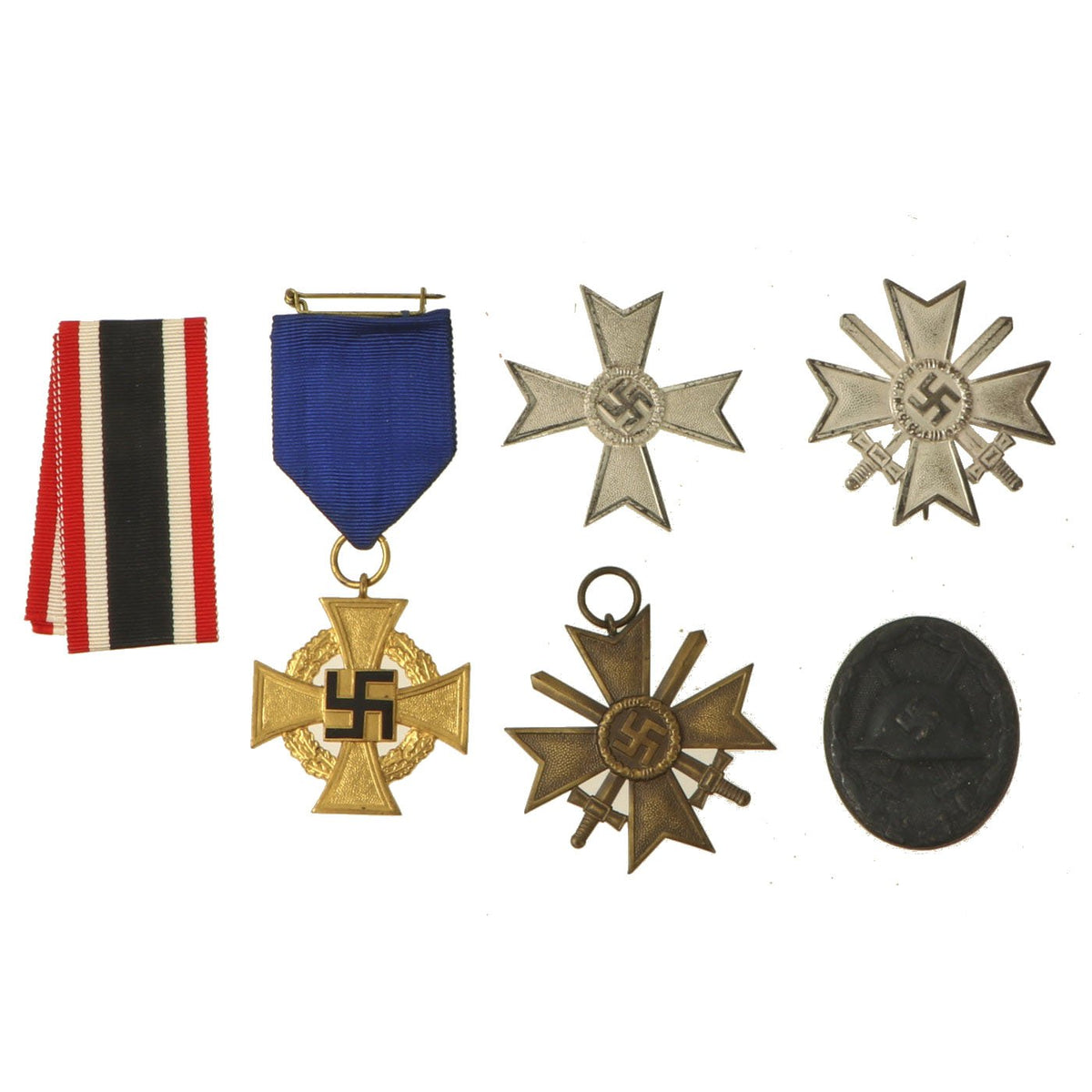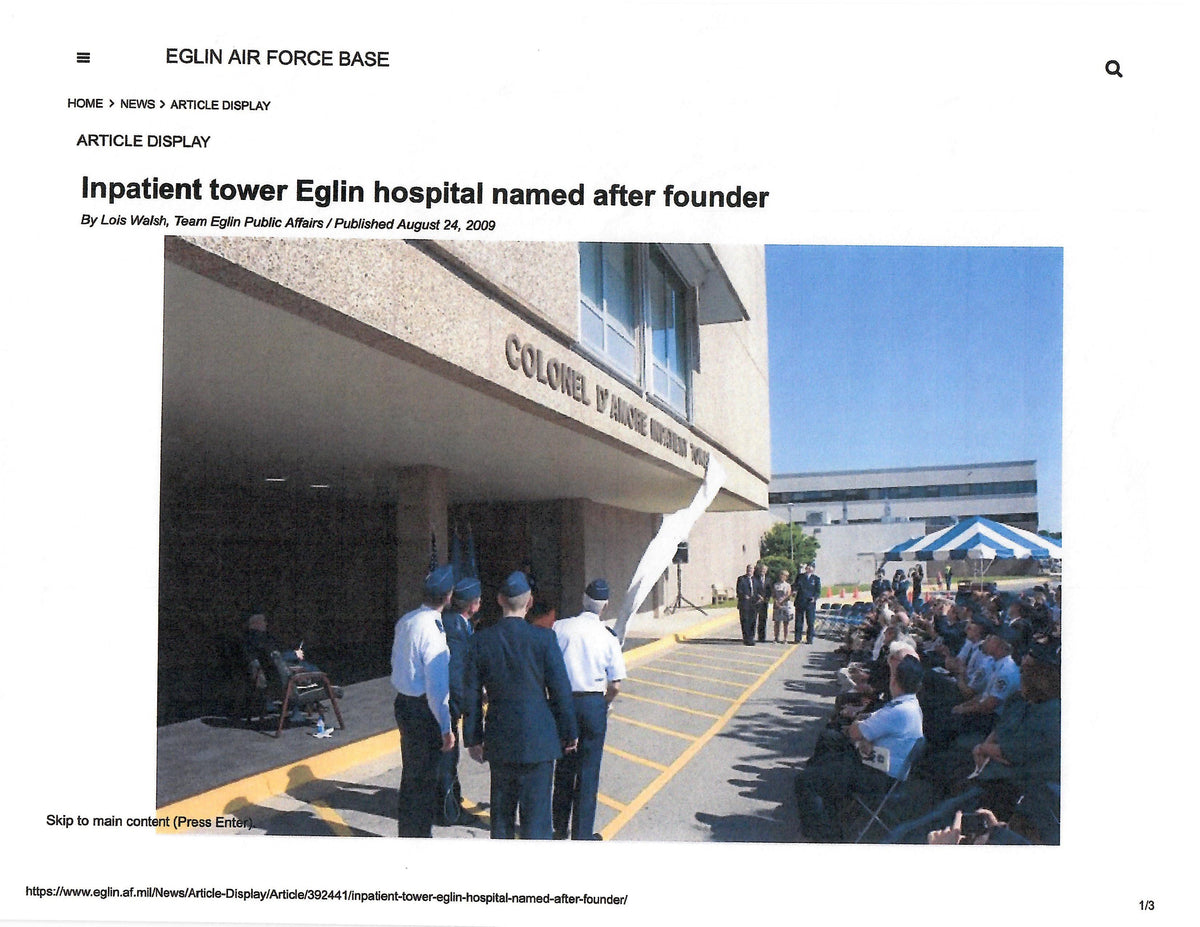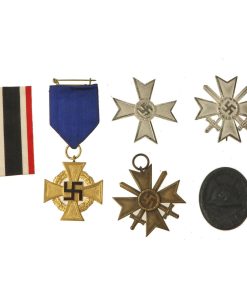Original German WWII Medal Group Captured by Col. Adanto A.S. D’Amore – Later Pacific War P.O.W. Original Items
$ 695,00 $ 208,50
Original Item: One-of-a-kind Set. During WWII, while most service members were sent to either the Pacific or Europe for the duration of the war, there were some who served in both theatres. Col. Adanto A.S. D’Amore was one such individual, and after brief service in the European theater, he was then was transferred to the Philippines as part of the 19th Bomb Group. He was then captured and spent the remainder of the war as a P.O.W. in both the Philippines and mainland Japan.
After the war, Col. D’Amore would continue his service, and transferred to the U.S. Air Force after it was created from the U.S. Army Air Forces. Eventually he became the hospital commander at Elgin Air Force Base, building it into a hospital that would meet the needs of an expanding base. He remained there until his retirement from the Air Force, and later the Inpatient Tower at Elgin Hospital was named in his honor.
Per the included signed and seal stamped emails, these awards were –
Included with each letter is a copy of Col. D’Amore’s discharge papers from 1968.
The included group consists of five German WWII awards, all offered in very good condition. It consists of the following:
- German WWII War Merit Cross 2nd Class with Swords and ribbon.
- German WWII War Merit Cross 1st Class Badge (without swords). There is a very tiny maker mark on the pin, but we cannot read it, even with a 16x magnifier.
- German WWII War Merit Cross 1st Class Badge with Swords.
- German WWII Hollow Back Black Wound Badge with steel body and intact pinback.
- German WWII Faithful Service Decoration 1st Class Cross for 40 Years of Service.
This is a wonderful set of medals in great shape, with a fantastic verified back story! Ready to cherish and display!
Below are more detailed descriptions of these awards:
War Merit Cross (Kriegsverdienstkreuz) with and without Swords (for Combat)
This was a decoration of NSDAP Germany during the Second World War, which could be awarded to military personnel and civilians alike. By the end of the war it was issued in four degrees, and had a related civil decoration. It was created by Adolf AH in October 1939 as a successor to the non-combatant Iron Cross which was used in earlier wars. The award was graded the same as the Iron Cross: War Merit Cross Second Class, War Merit Cross First Class, and Knights Cross of the War Merit Cross. The award had two variants: with swords given to soldiers for exceptional service “not in direct connection with combat”, and without swords for meritorious service to civilians in “furtherance of the war effort”. As with the Iron Cross, Recipients had to have the lower grade of the award before getting the next level.
The German Wound Badge (Verwundetenabzeichen) was instituted during the First World War to recognize those wounded in the conflict. It was designed using a World War One style Imperial German helmet as the main motif. The helmet was set on top two crossed swords against a pebbled background and surrounded by a laurel leaves wreath.
At the outbreak of war in September 1939 with Poland, Adolf AH once again reinstated the Wound Badge Award. Again the pattern of the badge was similar to that of the earlier style except the new design was freshened up a bit by using an M35 pattern German helmet and a slightly softer looking wreath. This pattern was used until the end of the war in 1945. It is impossible to know the exact numbers of wound badges awarded during the course of the Second World War due to the vast scale and countless individuals who were wounded or killed in the conflict.
The Wound Badge Awards came in three different types of grades representing the amount , or severity, of wounds received. The first grade, the Black Wound Badge was awarded for 1 to 2 wounds received in combat. The Silver Grade was awarded for 3 to 4 wounds, and finally the Gold Grade for 5 or more wounds, total disability, or death.
Faithful Service Decoration First Class Cross for 40 Years of Service – A fullsize frosted gold cross with an oak leaf wreath and black enameled Swas (hook cross) on original ribbon. The Civil Service Faithful Service Medal (Treudienst-Ehrenzeichen für Beamte Angestellte und Arbeiter im öffentlichen Dienst) was a NSDAP Germany medal of honor that was founded on 30 January 1938, in two grades, to reward civilians and military in the employ of the German public services for long and faithful service.
All officials, employees, and laborers at any level of the public service (local, regional or national) who complete 25 or 40 years service were eligible. The second class award was for 25 years of service was a silver cross, with a silver wreath and a black enameled swas in the center of the cross. The first class award was for 40 years of service was a gold cross, with a gold wreath and a black enameled swas in the center of the cross.
The reverse of both classes was stamped with Für treue Dienste (For faithful Services). in German black letter typeface. The ribbon for the medal is cornflower blue.
Fast Shipping with Professional Packaging
Thanks to our longstanding association with UPS FedEx DHL, and other major international carriers, we are able to provide a range of shipping options. Our warehouse staff is expertly trained and will wrap your products according to our exact and precise specifications. Prior to shipping, your goods will be thoroughly examined and securely secured. We ship to thousands clients each day across multiple countries. This shows how we're dedicated to be the largest retailer on the internet. Warehouses and distribution centres can be located throughout Europe as well as the USA.
Note: Orders with more than one item will be assigned a processing date depending on the item.
Before shipping before shipping, we'll conduct a thorough inspection of the items you have ordered. Today, the majority of orders will be delivered within 48 hours. The delivery time will be between 3-7 days.
Returns
The stock is dynamic and we cannot completely manage it because multiple stakeholders are involved, including our factory and warehouse. So the actual stock may alter at any time. It's possible that you may not receive your order once the order has been made.
Our policy is valid for a period of 30 days. If you don't receive the product within 30 days, we are not able to issue a refund or an exchange.
You can only return an item if it is unused and in the same state as the day you received it. You must have the item in its original packaging.
Related products
Uncategorized
Armoured Fighting Vehicles of the World: AFVs of World War One (Hardcover Book) New Made Items
Uncategorized
Armored Burgonet Helmet & Polearm from Scottish Castle Leith Hall Circa 1700 Original Items
Uncategorized
Uncategorized
Uncategorized
Uncategorized
Uncategorized
Uncategorized
Uncategorized
Uncategorized
Uncategorized
Uncategorized
Uncategorized
Uncategorized
Band of Brothers ORIGINAL GERMAN WWII Le. F.H. 18 10.5cm ARTILLERY PIECE Original Items
Uncategorized
Uncategorized
Uncategorized












































































